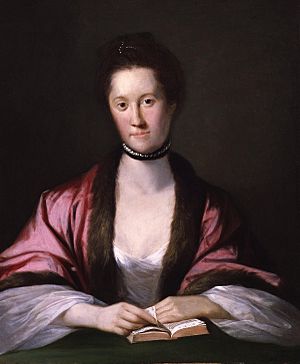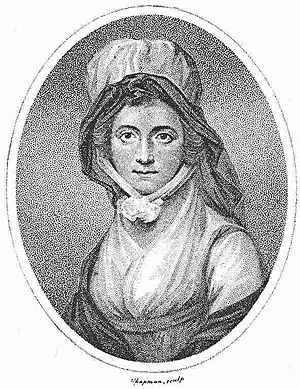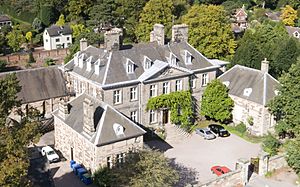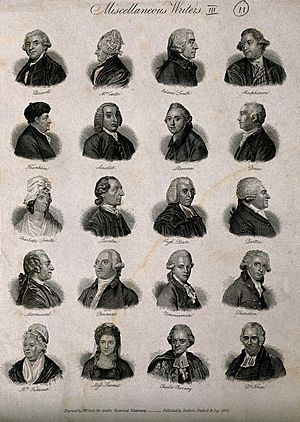Anna Seward facts for kids
Quick facts for kids
Anna Seward
|
|
|---|---|

Seward by Tilly Kettle, 1762
|
|
| Born | 12 December 1742 Eyam, Derbyshire
|
| Died | 25 March 1809 (aged 66) |
| Resting place | Lichfield Cathedral |
| Nationality | English |
| Occupation | Writer, botanist |
|
Notable work
|
Louisa (1784) |
| Parents |
|
| Relatives | Sarah ("Sally") (sister) |
Anna Seward (born December 12, 1742 – died March 25, 1809) was a famous English poet. People often called her the Swan of Lichfield. She was known for her Romantic poetry. Anna was lucky because her father believed in good education for girls. This was quite unusual for the time.
Contents
Anna Seward's Life Story
Her Family and Home
Anna Seward was born in 1742 in a mining village called Eyam in Derbyshire. Her father, Thomas Seward, was a priest and a writer. Anna was the older of two daughters who lived past childhood. She had other younger brothers and sisters, but they sadly died when they were babies. Anna wrote a poem called Eyam about losing them.
In 1749, when Anna was seven, her family moved to Lichfield. Her father became a special priest at Lichfield Cathedral. They moved into the Bishop's Palace in 1754. Anna's father taught her at home.
When Anna was 14, a family friend passed away. The Sewards took in one of her daughters, Honora Sneyd. Honora became like a foster sister to Anna. Anna's younger sister, Sarah, died suddenly at 19 in 1764. Anna was very sad but found comfort in Honora. She wrote poems about her feelings for both sisters.
Anna took care of her father for the last ten years of his life. He had a stroke, and she looked after him. When he died in 1790, he left her enough money to live comfortably. She stayed in the Bishop's Palace until she died in 1809.
How Anna Seward Learned and Grew
Anna was a very smart and sensitive child. She loved learning from a young age. Her father, Thomas Seward, believed that girls should have a good education. He even wrote about it. He encouraged Anna, and she could recite poems by Milton when she was only three!
Her talent for writing was clear by age seven. Their home in Lichfield became a meeting place for famous writers. People like Erasmus Darwin (a scientist and doctor) and Samuel Johnson (a famous writer) visited. Anna was encouraged to join their discussions. Her father taught her about poetry, math, and religion. He wanted her to be well-rounded, not just learn typical "girl" skills like drawing. He didn't teach her languages or science, but she could learn them on her own if she wanted.
Anna met many important people. She talked with Sir Walter Scott, who later published her poems. She was also part of a group called the Lunar Society in Birmingham. This group included thinkers and scientists like Erasmus Darwin. Anna wrote letters to other members, sharing her ideas.
Her writing talent became widely known at a special poetry gathering near Bath. Anna wrote a poem thanking the host, Lady Miller, for recognizing her skills.
Her Views on Relationships
Anna Seward never married. She was very open about her thoughts on marriage. She believed that friendship, based on equality and good values, was better than marriage. This idea was also seen in the books written by her step-niece, Maria Edgeworth. Anna even named her pet dog "Sappho" after a famous ancient poet.
Anna had a very close friendship with Honora Sneyd, her childhood friend. Anna wrote many poems expressing her deep feelings for Honora. When Honora married Richard Edgeworth and moved to Ireland, Anna felt very sad and even betrayed. Her poems show how intensely she felt about this friendship.
Anna Seward's Writings
Her Poems
Anna started writing poems early in life. Her father, who was also a poet, first encouraged her. But later, he worried she might become "too learned." However, Dr. Erasmus Darwin encouraged her again.
Anna wrote many poems, including sad poems called elegies and short poems called sonnets. She also wrote a novel in verse called Louisa (1784), which was very popular. Even though she started writing early, she didn't publish her first poem until she was 38 years old.
Some people, like Horace Walpole, didn't think her writing was very imaginative. But others, like Mary Scott, praised her. Many of her poems were about her close friend, Honora Sneyd. These poems are part of a tradition called "female friendship poetry." Anna's work was shared widely among her friends and other writers.
Sometimes, Anna worried that others might use her ideas or poems as their own. She once said, "a charge of plagiarism must rest somewhere," meaning someone was copying her work.
Letters and Biography
Anna Seward wrote a huge number of letters. Six large books of her letters were published after she died. These letters show how much she knew about English literature. They also give us a great look into the literary world of her time. Famous writers like Walter Scott and Samuel Johnson thought she was an expert on English literature. She also wrote a biography about Dr. Darwin called Memoirs of the Life of Dr. Darwin (1804).
Her Interest in Science
Anna was very interested in botany, which is the study of plants. She worked closely with the Lichfield Botanical Society. This group, even though it had "Society" in its name, only had three men: Erasmus Darwin, Sir Brooke Boothby, and John Jackson. Anna even published some writings for them without putting her name on them. This was common for women writers at the time.
Selected Works
Here are some of Anna Seward's important works:
- The Visions, an Elegy (1764)
- The Anniversary (1769)
- Lichfield, an elegy (May 1781)
- Poem to the Memory of Lady Miller (1782)
- Eyam. (August 1788)
- Louisa, A Poetical Novel in Four Epistles (1784)
- Memoirs of the Life of Dr. Darwin (1804)
- Original Sonnets on Various Subjects: And Odes Paraphrased from Horace (1799)
- Sonnet 10. To Honora Sneyd. [Honora, shou'd that cruel time arrive]
- Sonnet 14 [Ingratitude, how deadly is thy smart]
What She Left Behind
After Anna Seward died, Sir Walter Scott collected and published her poems in three books in 1810. He also wrote a short story about her life. Scott did remove some parts of her letters. Later, six more books of her letters were published in 1811.
For a while, people didn't remember Anna Seward much. But in the 21st century, interest in her work grew again. Today, many scholars see her as an important writer. She helped us understand how women's roles and relationships were changing in the late 1700s. She also played a role in the rise of Romanticism in literature.
There is a special plaque for Anna Seward in Lichfield Cathedral. She is buried under the choir stalls there. Her friend Walter Scott wrote the words on her tombstone. Anna Seward also appears as a character in a novel called The Ladies by Doris Grumbach.
Archives
You can find a collection of letters related to Anna Seward at the Cadbury Research Library, University of Birmingham.




